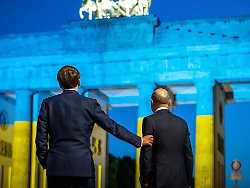“Support for Ukraine”
Scholz and Macron set signs in blue and yellow
05/10/2022 07:43 am
On Europe Day, the Brandenburg Gate lights up in the colors of Ukraine. Before that, French President Macron and Chancellor Scholz appear together. You want to convey a special message.
Chancellor Olaf Scholz and French President Emmanuel Macron expressed their support for Ukraine at the Brandenburg Gate in Berlin. On Monday evening, the two politicians visited the world-famous building, which was illuminated in the Ukrainian national colors of yellow and blue. When asked what message they wanted to convey with their action, Macron said: “Full support for Ukraine.”
Around 200 people had gathered in front of the Brandenburg Gate, some of whom waved Ukrainian flags. In addition, they kept calling out the name of the Ukrainian city of Mariupol, which was largely destroyed and taken by Russian troops.
Scholz had previously welcomed Macron’s proposal to create a “European political community” in the Chancellery. “I want to say explicitly that this is a very interesting proposal for dealing with the major challenges that we have,” said the Chancellor at a joint press conference with Macron.
Macron dampens hopes of quick EU accession
The French President had previously dampened hopes that Ukraine would join the EU quickly. The process of joining the EU could take “decades,” Macron said in the European Parliament in Strasbourg before his visit to Berlin. Instead, he proposed the creation of a “European political community” for Ukraine and other candidate countries.
Ukraine had applied to join the EU shortly after the Russian invasion of their country. The EU Commission is expected to issue its official statement in June, as Commission President Ursula von der Leyen announced.
“We agree that Ukraine belongs to the European family,” said Scholz. “We are working on continuing to accompany them on their way to our common Europe.”
If Brussels recommends candidate status for Ukraine to the 27 member states and if all countries agree to this, the actual accession negotiations could begin. In the lengthy process, the candidate country has to prove that it complies with the EU regulations.
